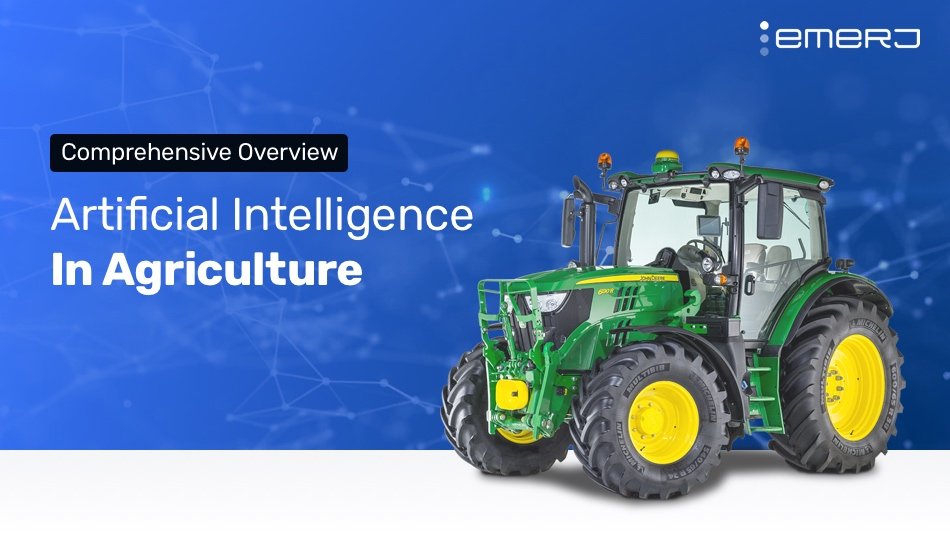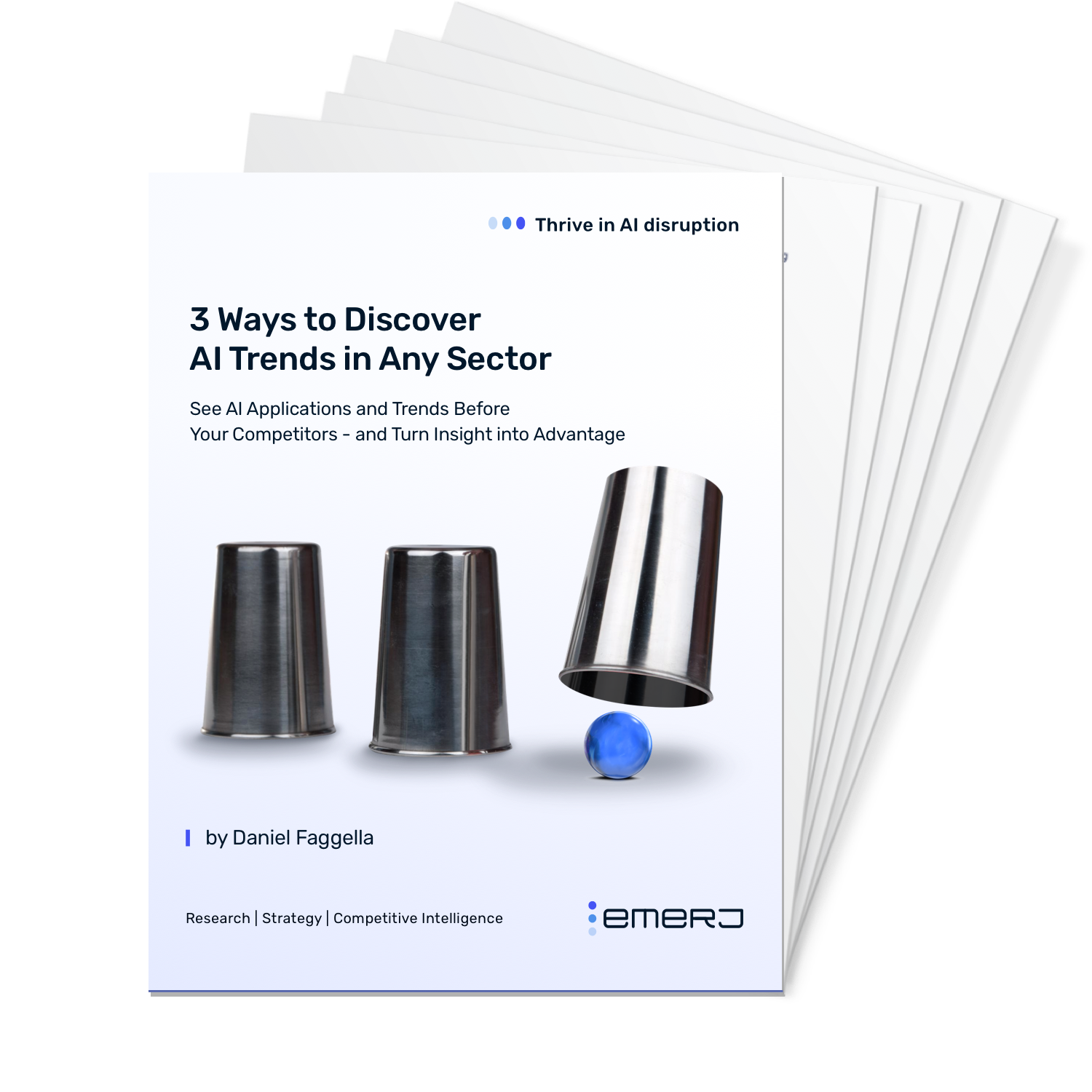
Agriculture is both a major industry and foundation of the economy. In 2016, the estimated value added by the agricultural industry was estimated at just under 1 percent of the US GDP. The US Environmental Protection Agency (EPA) estimates that agriculture contributes roughly $330 billion in annual revenue to the economy.
Factors such as climate change, population growth and food security concerns have propelled the industry into seeking more innovative approaches to protecting and improving crop yield. As a result, AI is steadily emerging as part of the industry’s technological evolution.
In this article we explore applications of artificial intelligence to provide business leaders with an understanding of current and emerging trends, and present representative examples of popular applications.

Artificial Intelligence in the Agricultural Industry – Insights Up Front
Based on our research, the most popular applications of AI in agriculture appear to fall into three major categories:
- Agricultural Robots – Companies are developing and programming autonomous robots to handle essential agricultural tasks such as harvesting crops at a higher volume and faster pace than human laborers.
- Crop and Soil Monitoring – Companies are leveraging computer vision and deep-learning algorithms to process data captured by drones and/or software-based technology to monitor crop and soil health.
- Predictive Analytics – Machine learning models are being developed to track and predict various environmental impacts on crop yield such as weather changes.
In the full article below, we’ll explore each category of AI applications in the agricultural industry, along with representative companies, use-cases, and videos. For further insights on the topic, we published an entire article on the current AI initiatives in agriculture in India.
Agricultural Robotics
Blue River Technology – Weed Control
The ability to control weeds is a top priority for farmers and an ongoing challenge as herbicide resistance becomes more commonplace. Today, an estimated 250 species of weeds have become resistance to herbicides. In a research study conducted by the Weed Science Society of America on the impact of uncontrolled weeds on corn and soybean crops, annual losses to farmers are estimated at $43 billion.
Companies are using automation and robotics to help farmers find more efficient ways to protect their crops from weeds. Blue River Technology has developed a robot called See & Spray which reportedly leverages computer vision to monitor and precisely spray weeds on cotton plants. Precision spraying can help prevent herbicide resistance. The short video below demonstrates how the robot works in action:
According to its website, the company claims that its precision technology eliminates 80 percent of the volume of chemicals normally sprayed on crops and can reduce herbicide expenditures by 90 percent. It has been estimated that over 1 billion pounds of pesticides are used in the US annually. ve
In September 2017, major manufacturing company John Deere announced its acquisition of Blue River Technology. John Deere is reportedly investing $305 million to complete the transition. The company claims that the original Blue Technology firm and current staff will remain in Sunnyvale where John Deere hopes to continuing growing the firm.
(Blue River Technology is one of many vendors listed in our robotics / vehicle vendor section here at Emerj.)
Harvest CROO Robotics – Crop Harvesting
Automation is also emerging in an effort to help address challenges in the labor force. The industry is projected to experience a 6 percent decline in agricultural workers from 2014 to 2024.
Harvest CROO Robotics has developed a robot to help strawberry farmers pick and pack their crops. Lack of laborers has reportedly led to millions of dollars of revenue losses in key farming regions such as California and Arizona. In the Hillsborough County, Florida region which has been described as the “nation’s winter strawberry capital,” between 10,000 and 11,000 acres of strawberries are typically harvested in a season.
Harvest CROO Robotics claims that its robot can harvest 8 acres in a single day and replace 30 human laborers. In the news clip video below features a demo of the Harvest CROO robot:
An estimated 40 percent of annual farm costs are funneled into “wages, salaries and contract labor expenses” for crops such as fruits and vegetables where labor needs tend to be the highest.
In June 2017, Florida-based Wish Farms announced its implementation of Harvest CROO Robotics’ strawberry harvester in the summer of 2017. The farm claims that the robot spans “over six beds of plants” and carries “16 individual picking robots.” To date, Harvest CROO Robotics has reportedly raised $2.8 million from investors and farms representing 20 percent of all U.S. strawberry production.
Crop and Soil Health Monitoring
PEAT – Machine Vision for Diagnosing Pests / Soil Defects
Deforestation and degradation of soil quality remain significant threats to food security and have a negative impact on the the economy. Domestically, the USDA has estimated that the annual cost of soil erosion is approximately $44 billion dollars.
Berlin-based agricultural tech startup PEAT, has developed a deep learning application called Plantix that reportedly identifies potential defects and nutrient deficiencies in soil. Analysis is conducted by software algorithms which correlate particular foliage patterns with certain soil defects, plant pests and diseases.
The image recognition app identifies possible defects through images captured by the user’s smartphone camera. Users are then provided with soil restoration techniques, tips and other possible solutions as explained in the short video below:
The company claims that its software can rapidly achieve pattern detection with an estimated accuracy of up to 95 percent. PEAT recently published that its international clientele base had reached over 500,000. The company does acknowledge its partners, and client quotes on its website but specific case studies do not appear to be available.
Without specifics regarding the size of client farms, we are unable to confirm if the Plantix app poses any significant limitations for larger farms. Competitor CropDiagnosis appears to follow a similar model for its app.
Trace Genomics – Machine Learning for Diagnosing Soil Defects
Similar to the Plantix app, California-based Trace Genomics, provides soil analysis services to farmers. Lead investor Illumina helped develop the system which uses machine learning to provide clients with a sense of their soil’s strengths and weaknesses. The emphasis is on preventing defective crops and optimizing the potential for healthy crop production.
According to the company’s website, after submitting a sample of their soil to Trace Genomics, users reportedly receive an in-depth summary of their soils contents. Services are provided in packages which include a pathogen screening focused on bacteria and fungi as well as a comprehensive microbial evaluation. As described in the video below, an analysis of soil DNA is also central to Trace’s system:
Video: <iframe src=’//players.brightcove.net/2097119709001/4kXWOFbfYx_default/index.html?videoId=5502727538001′ allowfullscreen frameborder=0></iframe>
As of February 2017, the company has raised $8 million in total equity funding from six firms including the Illumina Accelerator. Product packages begin at $199 for the Pathogen Screen. Favorable quotes from two farms are featured on the Trace Genomics website. However, data indicating how Trace Genomics specifically improved outcomes is not included
SkySquirrel Technologies Inc. – Drones and Computer Vision for Crop Analysis
The presence of drones in agriculture reportedly dates back to the 1980s for crop dusting in Japan. The market for drones in agriculture is projected to reach $480 million by 2027. Today, companies are leveraging AI and aerial technology to monitor crop health.
SkySquirrel Technologies Inc. is one of the companies bringing drone technology to vineyards. The company aims to help users improve their crop yield and to reduce costs. Users pre-program the drone’s route and once deployed the device will leverage computer vision to record images which will be used for analysis.
Once the drone completes its route, users can transfer a USB drive from the drone to a computer and upload the captured data to a cloud drive. SkySquirrel uses algorithms to integrate and analyze the captured images and data to provide a detailed report on the health of the vineyard, specifically the condition of grapevine leaves. Since grapevine leaves are often telltales for grapevine diseases (such as molds and bacteria), reading the “health” of the leaves is often a good proxy for understanding the health of the plants and their fruit as a whole.
The SkySquirrel Technologies team provides an overview of how the drone functions in the short video demonstration below:
The company claims that its technology can scan a 50 acres in 24 minutes and provides data analysis with 95 percent accuracy. Specific use cases do not appear to be available on the company’s website.
(Readers with a specific interest in drones may be interested in our full article called “5 Industrial Drone Applications“.)
Predictive Analytics
aWhere – Satellites for Weather Prediction and Crop Sustainability
aWhere, a Colorado based company uses machine learning algorithms in connection with satellites to predict weather, analyze crop sustainability and evaluate farms for the presence of diseases and pests.
For example, daily weather predictions, are customized based on the needs of each client and and range from hyperlocal to global. Types of clients mentioned on the company’s website include farmers, crop consultants and researchers. We’ve covered AI for weather prediction earlier this year, but the video below gives a good idea of some of the fundamental technologies at play.
As shown in the 3 minute video below, the company claims to specialize in providing a high quality of data that is continuously updated at a rapid rate:
The company also claims that it provides its users with access to over a billion points of agronomic data on a daily basis. Data sources include temperature, precipitation, wind speed, and solar radiation, “along with comparisons to historic values for anywhere on the agricultural earth.”
The company does not appear to provide any case studies on its website. Software application examples are featured in the company’s blog but it is unclear how much clients have invested in aWhere’s services and how those investments have impacted outcomes.
FarmShots – Satellites for Monitoring Crop Health and Sustainability
Based in Raleigh, North Carolina, FarmShots is another startup focused on analyzing agricultural data derived from images captured by satellites and drones. Specifically, the company aims to “detect diseases, pests, and poor plant nutrition on farms.”
For example, the company claims that its software can inform users exactly where fertilizer is needed and can reduce the amount of fertilizer used by nearly 40 percent. The software is marketed for use across mobile devices.
The 40 second tutorial below demonstrates how to generate a report from captured data using FarmShots software:
In April 2017, FarmShots along with its associate partner, Planet, announced limited free access to its products for John Deere clients through June 2017. This collaboration offers another glimpse into John Deere’s interests in expanding into the agricultural tech space. FarmShots does not appear to feature examples of specific clients or case studies on its website.
Concluding Thoughts
AI-driven technologies are emerging to help improve efficiency and to address challenges facing the industry including, crop yield, soil health and herbicide-resistance. Agricultural robots are poised to become a highly valued application of AI in this sector.
Evidence of wide adoption is apparent in the dairy farming where thousands of milking robots are already operating. This segment is anticipated to increase from a $1.9 billion to $8 billion industry by 2023.
It is feasible that agricultural robots will be developed to complete an increasing diverse array of tasks in the next three to five years.
Crop and soil monitoring technologies will also be important applications going forward as climate change continues to be researched and evaluated. One research study reported that climate change evaluated from 1980 to 2008 resulted in a 3.8 percent global reduction of maize and a 5.5 percent reduction of wheat.
The amount of data that can potentially be captured by technologies such as drones, and satellites on a daily basis will give agricultural business a new ability to predict changes and identify opportunities. We predict that satellite machine vision applications (for weather, crop health, predicting crop yield, etc) will become more and more commonplace for large industrial farms in the coming 5-10 years
It will be important that farmers are equipped with training that is up-to-date to ensure the technologies are used and continue to improve. This will help to prove the value of these tools over the long haul.
Additionally, extensive testing and validation of emerging AI applications in this sector will be critical as agriculture is impacted by environmental factors that cannot be controlled unlike other industries where risk is easier to model and predict.
We anticipate that the agricultural industry will continue to see steady adoption of AI and will continue to monitor this trend.
Header image credit: Leica Geosystems







